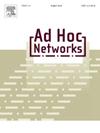物联网设备的混合自适应QoS和QoS驱动RAT选择策略
IF 4.4
3区 计算机科学
Q1 COMPUTER SCIENCE, INFORMATION SYSTEMS
引用次数: 0
摘要
近年来,物联网(IoT)经历了爆炸式增长,它使基于将众多设备连接到互联网的新应用成为可能。然而,越来越多的物联网设备利用各种无线接入技术(rat),每种技术都有不同的通信要求,在这种异构、多技术、多用户和多应用环境中确保可靠的服务质量(QoS)方面提出了重大挑战。因此,为了正确选择RAT,本文提出了一种基于深度强化学习(DRL)的混合自适应方法,该方法结合了QoS和体验质量(QoE)因素。与之前的研究不同,我们的方法集成了QoS参数和自适应网络信任因子,该因子反映了基于可靠的过去设备体验的用户QoE,最终为用户提供了始终如一的更好的连接。在我们的框架中,物联网设备根据服务需求和分配给RAT的信任分数,以分布式方式动态选择其RAT,反映其对过去RAT行为的满意度。采用网络模拟器3 (Network Simulator 3, NS3)进行的仿真表明,所提出的混合自适应RAT选择方法满足各种应用在任何时间的QoS要求。与其他方法相比,能耗降低64.12%,网络切换率降低37.73%,平均分组分发率提高17.85%。这证明了所提出的方法在优化能源效率和网络性能方面的有效性,确保物联网应用系统更加可靠和可持续。本文章由计算机程序翻译,如有差异,请以英文原文为准。
A hybrid and self-adaptive QoS and QoE-driven RAT selection strategy for IoT devices
In recent years, the Internet of Things (IoT) has witnessed an explosion, which enables new applications based on connecting numerous devices to the Internet. However, the increasing number of IoT devices utilizing various Radio Access Technologies (RATs), each with distinct communication requirements, presents significant challenges in ensuring reliable Quality of Service (QoS) in such a heterogeneous, multi-technology, multi-user, and multi-application environment. Therefore, for a proper RAT selection, this paper proposes a novel hybrid and adaptive approach based on Deep Reinforcement Learning (DRL) that combines QoS and Quality of Experience (QoE) factors. Unlike previous research, our approach integrates QoS parameters and an adaptive network trust factor that reflects the user's QoE based on reliable past device experiences, ultimately providing users with consistently better connectivity. Within our framework, an IoT device dynamically selects its RAT in a distributed manner based on service requirements and the trust score it assigns to RATs, reflecting its satisfaction with past RAT behavior. The proposed hybrid and adaptive RAT selection approach meets QoS requirements, for various applications at any time as indicated by simulations run using Network Simulator 3 (NS3). Compared to other methods, the energy consumption was reduced by 64.12%, network handovers were decreased by 37.73%, while the average packet delivery ratio was improved by 17.85%. This demonstrates the effectiveness of the proposed approach in optimizing both energy efficiency and network performance, ensuring a more reliable and sustainable system for IoT applications.
求助全文
通过发布文献求助,成功后即可免费获取论文全文。
去求助
来源期刊

Ad Hoc Networks
工程技术-电信学
CiteScore
10.20
自引率
4.20%
发文量
131
审稿时长
4.8 months
期刊介绍:
The Ad Hoc Networks is an international and archival journal providing a publication vehicle for complete coverage of all topics of interest to those involved in ad hoc and sensor networking areas. The Ad Hoc Networks considers original, high quality and unpublished contributions addressing all aspects of ad hoc and sensor networks. Specific areas of interest include, but are not limited to:
Mobile and Wireless Ad Hoc Networks
Sensor Networks
Wireless Local and Personal Area Networks
Home Networks
Ad Hoc Networks of Autonomous Intelligent Systems
Novel Architectures for Ad Hoc and Sensor Networks
Self-organizing Network Architectures and Protocols
Transport Layer Protocols
Routing protocols (unicast, multicast, geocast, etc.)
Media Access Control Techniques
Error Control Schemes
Power-Aware, Low-Power and Energy-Efficient Designs
Synchronization and Scheduling Issues
Mobility Management
Mobility-Tolerant Communication Protocols
Location Tracking and Location-based Services
Resource and Information Management
Security and Fault-Tolerance Issues
Hardware and Software Platforms, Systems, and Testbeds
Experimental and Prototype Results
Quality-of-Service Issues
Cross-Layer Interactions
Scalability Issues
Performance Analysis and Simulation of Protocols.
 求助内容:
求助内容: 应助结果提醒方式:
应助结果提醒方式:


